Powerful online learning at your pace


The 3 Reads Protocol for Solving Word Problems
Raise your hand if you wish your students were more confident and successful in solving word problems. Right, that’s what I thought. And the answer probably doesn’t change much based on your grade level. Face it, word problems are just plain hard!
What DOESN’T WORK
Over the years, very well-intentioned teachers have developed strategies designed to help students solve word problems . Two such strategies that are still quite prevalent are “problem-solving” models and the use of keywords. The idea is that if you follow these steps and look for these keywords, you will be able to solve any word problem. Unfortunately, it’s just not that simple, and despite their widespread use, these strategies are not very effective.

If you look at the CUBES problem-solving model, reading the problem is not even one of the steps! And if you’re thinking, Well, of course students know to read the problem! you might want to watch this model in action. I have more often than not seen students just literally start circling numbers (and not even the labels that go with the numbers…) without ever having read the problem. And keywords are not reliable either. Some word problems have no keywords, and keywords in multi-step problems end up confusing students because of the mixed messages they send.
So can we just agree that something else is needed and put these “strategies” to rest? Students fail at solving word problems for one reason—they don’t understand what the problem is asking them to do. It’s a comprehension problem, so students need reading comprehension skills.
The 3 Reads Protocol
Let me first say that if you search the Internet for 3 Reads Protocol , you’ll find that there are slightly differing versions. What I’m about to describe is the version that I find to be particularly effective. Regardless of the version, we are reading the problem three different times and each reading has a different focus.

The 3 Reads Protocol is a guided learning experience. Students are presented with the problem in stages, and with each read the teacher asks probing questions. Looking at an example is probably the easiest way to understand the protocol, so let’s dive in.

To begin the 3 Reads Protocol, the teacher presents the students with a problem, and the class reads the problem together. Probably the easiest way to do this is with a PowerPoint or Google Slides file. Notice that with the first read, there are no numbers and no question. We just want the students to understand what the story is about and make a mental picture. Without numbers, students have to focus on the meaning of the words! After reading the problem together, the teacher asks what the story is about and calls on students for responses. Don’t be surprised if the responses are very general at first ( girls, flowers, etc.). Ask for additional details, if necessary. Ideally, for this problem, you’d like the students to offer the names of the girls and the types of flowers.

For the second read, the problem is again presented to the students, but this time it includes the numbers. Read the problem again whole class. The questions you will ask now are all related to the numbers in the story. Our goal is for the students to understand that it’s not just 10, it’s 10 daisies . Students might also offer relationships—e.g., Natassja picked more daisies than Ayriale.

Finally, with the third read, students are asked to generate questions that could be answered using the information in the problem. Even though the problem looks just like it did for the second read, don’t skip the reading part! Some problems won’t lend themselves to very many different questions. I like to use this problem as an example because many different questions can be generated. Why? Because there are lots of different numbers in the problem. Here’s a sampling of questions that could be asked. I’m sure you can think of many others.
- How many flowers did Ayriale pick?
- How many flowers did Ayriale and Natassja pick?
- Which girl picked more flowers? How many more?
- How many daisies did the girls pick?
That’s the protocol in a nutshell! Once a question or questions have been generated, you can have students go on to solve the problem.
Frequently asked questions
1. When students are solving word problems independently, do I ask them to ignore the numbers and the question?
No! That would be pretty much impossible for them to do. By routinely solving problems using the 3 Reads Protocol with either the whole class or in small groups, you are helping students develop good reading habits that will transfer to their independent work. When they are working independently, the idea is that they will automatically think about the context, identify what the numbers mean within that context, and better understand what the question is asking them to find.
2. Where do I find problems for the 3 Reads Protocol?
I’m sure you can find some that have already been prepared, but it’s super easy to make your own! Just set up a PowerPoint or Google Slides file and format it however you like. Maybe you want a colorful border or a particular font. Use problems that you already have from your resources—textbooks, supplemental books, etc. You’ll need two slides for each problem. On the first slide, type the problem from your resource, leaving out the numbers and the question. On the second slide, add in the numbers. Use a nice big font so students can easily read the problem when projected on your interactive whiteboard. That’s all there is to it!
If you have other questions, add them in the comments below, and I’ll add them to the FAQ. I’d also love to hear how the 3 Reads Protocol is working out in your classroom!

Similar Posts

Early Place Value Experiences
I’ve been working with my firsties on understanding numbers to 50. We’ve practiced counting forwards and backward, writing and reading the numbers, as well as comparing numbers. By far our…

Video for Counting Back from 20–Shake Your Groove Thing!
I’m hanging out in one of my Kinder classes, and I’m having a blast! Check out this great video from Have Fun Teaching for counting back from 20. They have…

What I’m Reading…Intentional Talk
“When we press beyond procedural explanations into explanations that include reasoning, we are supporting students in justifying their ideas.” Intentional Talk (Kazemi/Hintz) When you are planning instruction, how often do…

Addictive Game for Practicing Combinations for Ten
Because ten has such importance in our number system, students need lots of opportunities to explore the combinations for ten. Back when I pulled small intervention groups for grades 1-5,…

Composing and Decomposing Numbers
One of the reasons I love teaching math is that it is so much different now than when I was in elementary school (Google paleolithic age for a frame of…

Using a Frayer Model for Math
A Frayer Model is a graphical organizer used to define and understand a concept by examining its definition, characteristics, examples, and non-examples. Frayer Models are typically used for vocabulary. but…
16 Comments
fantastic thoughts! I LOVE this approach. I’ve used a resource from Lucky Little Learners that is called Numberless Word Problems. This 3 reads protocol will work perfectly with that resource!
Yes! It does include elements of numberless word problems, which I was first introduced to by Brian Bushart .
I appreciate your thoughts on problem solving however the use of CUBES has been totally effective for the past three years with my students who never attempt word problems. You stated that not circling the “labels”, I suppose you mean units connected to the problem. I use this strategy daily and we circle both numbers and units. I’ve made it my own. Let me also reiterate that this strategy works exceptionally well with students who have low reading abilities too. I spend 5 weeks on CUBES and we slowly work our way into the Three Read Protocol which also helps the “non-reader”
Thank you for sharing your experiences! Since you transition to Three Reads, I’m curious why you wouldn’t start with it. I’d also be interested to know what grade level you teach.
I teach both 7th and 8th grade, and many times they have not had any experience with either. CUBEs is embedded with 3-read. I read the question. Students read the questions, we use cubes to understand quantities and the operations ( C and B) used to bring these quantities together. Then we underline the question to provide clarity and to determine what type of answer we are seeking. In our data, we found that our students do not attempt word problems on any formative assessments so we had to start with decreasing student fear of problem-solving and reading. When I used CUBES, I found that many students could answer the question however they had no idea what to do (operations) with the numbers due to a lack of experience,(key operational words) not knowledge ( they always wanted to add). Immediately, students would attempt word problems because CUBES allowed them to pull out what they needed, producing increased math confidence. As we continued with problem-solving, the 3 read protocol was introduced when solving multi-step word problems, student growth was tremendous!
Excellent post!
Thank you! This strategy has so much potential for teaching students to approach word problems in a much more meaningful way!
Hello! This strategy looks great and reaffirms how I’ve been teaching my son to read the problems through as many times as he needs to understand. Now I have the right questions to ask with each reading! Thank you! My question, are there still some strategies to go along with this protocol that you have found to be helpful to use in conjunction i.e. drawing a picture, making a chart, etc. Thanks so much!
I’m so glad this provides you with the missing link! Drawing a picture or diagram is another powerful strategy that goes really well with 3 Reads because it helps students visualize what’s going on in the problem.
Thank you for your post. The Three Read strategy is a gentle reminder of the power of cross-curricular reading strategies; coupling this annotation and graphic organizers will help students develop ways to process and solve simple to more complex multi-step word problems.
I am a math interventionist at an elementary school. We see students K-5 and realize how important it is for us to have a common process/language when it comes to word problems. Looking forward to learning more about this and helping guide our school, thank you!
I absolutely agree about using common language and strategies campus-wide! It’s so much more effective than students having to adjust to their teacher’s language/strategies every new year.
Thank you! I am going to try Three Reads Protocol for the first time next week with my 4th grade students. I am excited. I have had students read word problems all the way through before trying to solve the problem, however, I love the 3 Reads approach and the questions that go with each read. Thank you for breaking it down.
It’s a very powerful strategy! Good luck.
Many of the problems already include the question or questions. When first teaching the strategy, I can take the questions away and then we can compare to see if one of our questions matched the questions posed, but how to do facilitate the strategy when the question is there and you can’t take it away (thinking of assessments).
The idea is that when done regularly, students will develop comprehension skills that will transfer to solving “normal” word problems. They’ll know, for example, that reading it through the first time and ignoring the numbers helps them focus on what’s happening in the problem. You certainly want to help them make that connection, though. You might even show them a normal problem and explicitly model how to use 3 read strategies when the numbers and question are present.
Leave a Reply Cancel reply
Your email address will not be published. Required fields are marked *

VISIT MY TPT STORE

3 Reads Strategy for Successful Problem Solving in Math
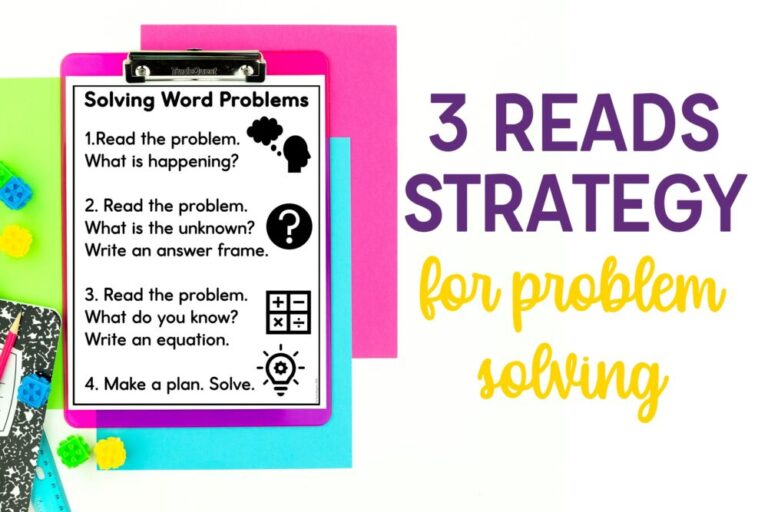
Word Problems are often the hardest part of our math instruction. They can visually overwhelm students. They often contain extraneous information or multiple steps for completion. Students often struggle to persevere through complex problems. But, ultimately, it is through these complex problems that we are able to truly see our students’ understanding of math concepts and proficiency with the standards. Our students are expected to persevere through solving them, to demonstrate understanding, and to use a variety of strategies. I detail my experience with difficulties with story problems in my post Why Your Students Struggle with Word Problems . I use a modified 3 Reads Strategy in my classroom to help students make sense of complex word problems during our Word Problem of the Day . I connect it to the Close Reading we do during E/LA.
We have to read the problem closely to truly understand what is being asked of us as mathematicians.
The 3 Reads Strategy is a series of steps that helps students make sense of word problems. It’s focused on understanding the context. There are a variety of interpretations of the protocol. I have found my students have been increasingly successful following the 3 Read protocol daily. We do it during our Word Problem of the Day routine so we practice nearly every single day. At the beginning of the year, I walk my students through the 3 reads and we talk about the steps with each read. As the weeks go on, my scaffolding decreases as I expect students to apply the same steps independently. I often, especially with more complex word problems, do the first reading orally to provide access for all students. Here are the steps we take during our 3 Reads Routine.
3 Reads Strategy for Word Problems
1st read: read for gist.
The purpose of the first read is to get the gist of the word problem. Students should be able to answer what the problem is about; the context . Students should be able to retell, in their own words, what is happening in the word problem.
2nd Read: Read for the Unknown
The second read is focused on the unknown ; what is being solved for. Identifying the unknown helps students identify important and necessary information for solving during the third read. This helps them parse extraneous information out. It also helps students ensure they’re solving for what is actually being asked. I have my students underline important information in the question and also write a sentence frame for the solution.
3rd Read: Read for Quantities
In this read, students identify the quantities and relevant units. During this read, I have students circle the numbers and underline the key words (most often the units) for solving. It’s important to note that I do not mean keywords that are typically words relating to operations such as more. In this read, we focus on what is known ; the information given. With the unknown already being identified. Students then write an equation or expression to solve. They may also draw a picture if it’s helpful understanding the steps needed for solving.
Make a Plan
The last step in the 3 read protocol is to make a plan for solving. Now that students have identified what is being asked, the information that’s given to them, and what they are solving for, the last step is to actually solve. That may include modeling the problem with base ten blocks. It may also include using the standard algorithm to solve. Whatever strategy students feel they need, they do.
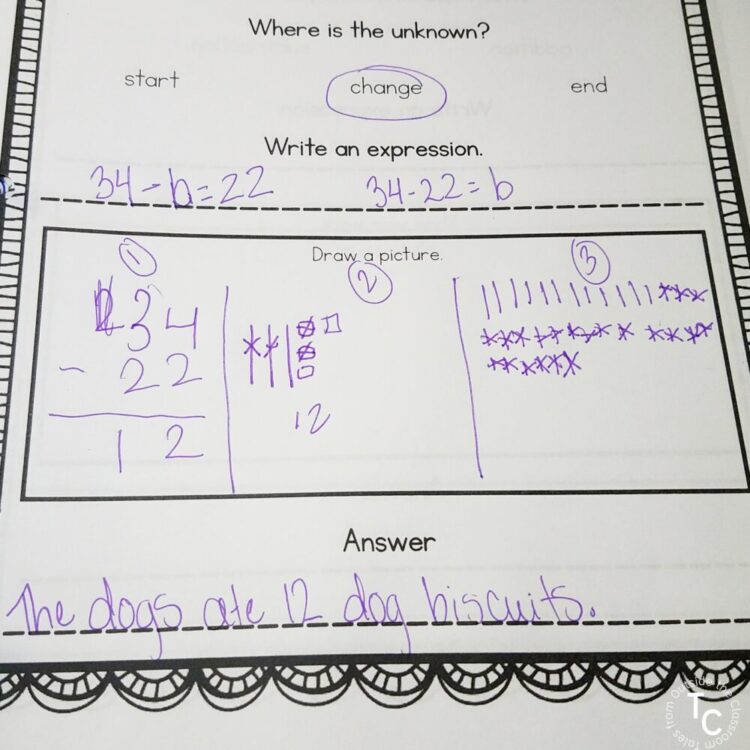
After students have worked through the problem, we share solutions and strategies. The focus is on so much more than a correct solution! I have students show their work and explain their thinking. Through our conversation we may critique someone else’s work to identify their mistake. We may share a variety of strategies for solving the equation. We may compare equations or expressions that were written for the problem. Because I’m walking around while students are working independently, I’m able to give on the spot support to some kids, while also identifying things I want to highlight for the group. This routine, and our steps after, go through so many of the Standards for Mathematical Practice!
It’s great to have a 3 Reads anchor chart or poster for student reference. A co-created anchor chart constructed with students while solving a complex problem would be great! I also have free black & white 3 Read Strategy posters that are perfect for printing on colored Astrobrights paper and made into a bulletin board. There’s also a 1-page 3 Reads Math Routine Poster that’s designed for student use.
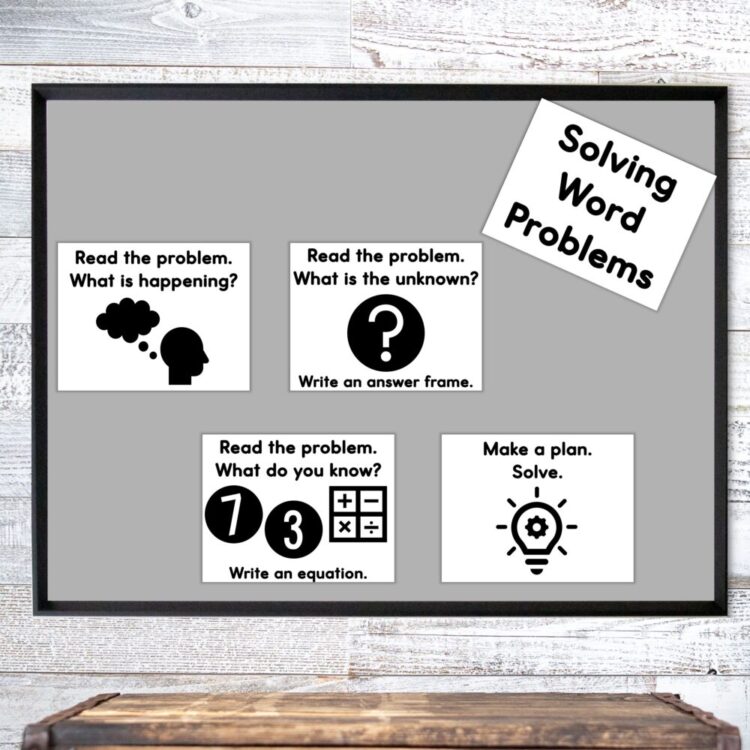
Download the 3 Reads Routine posters here .
After students work to solve, we go over the problem. I scaffold the routine at the beginning of the year so we do each piece together. But as the weeks go on, I expect my students to become more and more independent in using the 3 Reads strategy. If they aren’t doing it independently when we’re working together, they’re not going to be using it independently in their work. Much of the power of our work comes from the discourse around the problem AND how students solved it. Depending on the problem, there can be value in focusing on the context and unknown. For others, the computation and strategies for solving may be the focus. I vary what our math discourse looks like. Some days, students talk with a partner as they work. Others, they talk with a partner after. Many times, it’s a whole class discussion.
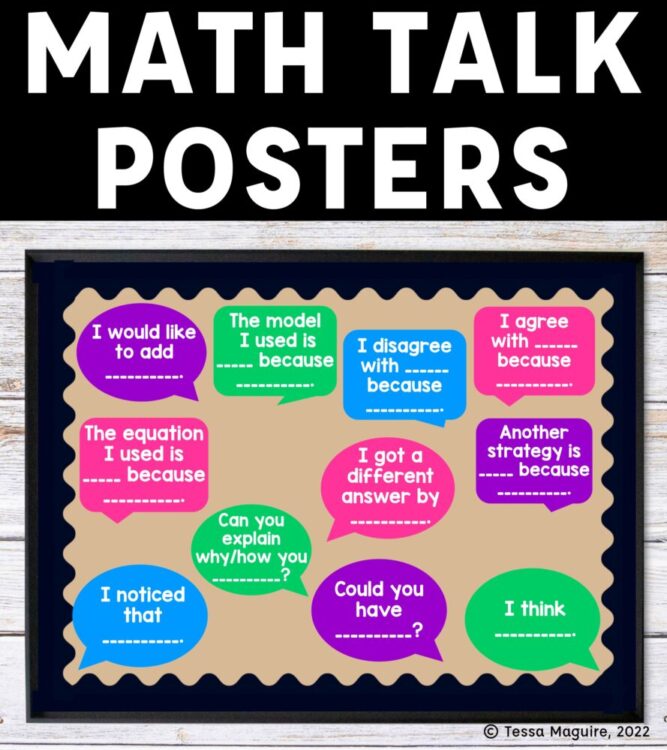
These Math Talk posters help remind students of how they can engage in the classroom discourse around our word problem. They’re the perfect supplement to the 3 Reads Strategy because they refer back to the steps students followed based on the context of the problem. You can get My Math Talk posters for free in your inbox by filling out the form below.
Sign up to receive your free Math Talk Sentence Stem posters! After confirming your email, you’ll receive the file and be signed up for my weekly newsletter.
Loading…
You have successfully joined our subscriber list.
We use our 3 Reads Strategy during our Word Problem of the Day routine. You can read more about it in the blog post linked below. If you want to take a closer look at my Word Problem of the Day Bundles for 1st, 2nd, and 3rd grades, I have them in my TpT store. Each bundle includes a free Back to School version that gives you a great look at the format of the problems.
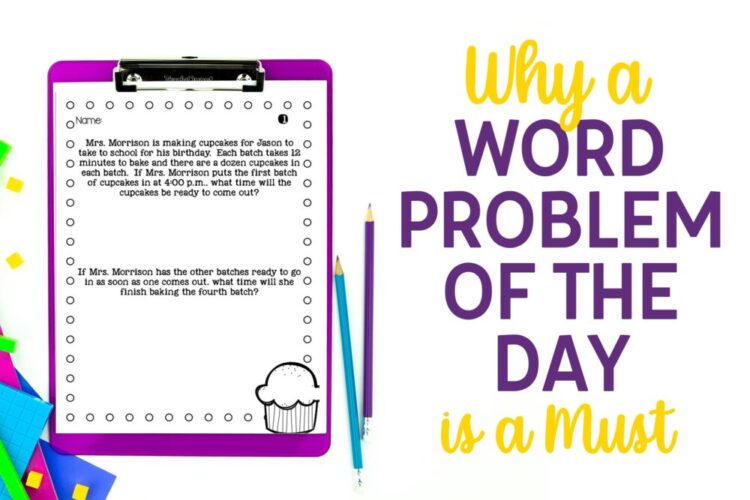
Newsletter Sign Up
Signup for my weekly-ish newsletter. I send out exclusive freebies, tips and strategies for your classroom, and more!
Please Read!
You have successfully joined our subscriber list. Please look in your e-mail and spam folder for Tales from Outside the Classroom. Often, the confirmation email gets overlooked and you're night signed up until you confirm!
I am one of the teachers that are teaching Word Problems wrong! I’ve read through all you said and it makes sense. Will use your strategy as our term starts tomorrow and this term the focus is on Word problems. Thanks for sharing. Do appreciate it.
I hope it helps you and your kiddos!
Leave a Reply Cancel reply
Your email address will not be published. Required fields are marked *
Save my name, email, and website in this browser for the next time I comment.
This site uses Akismet to reduce spam. Learn how your comment data is processed .
LOOKING TO SUPPLEMENT?
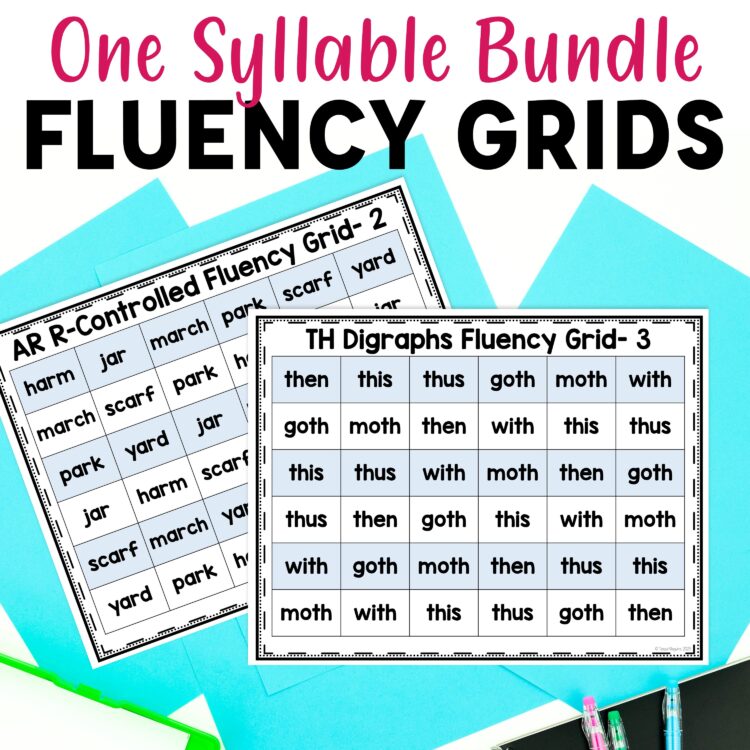
▹ NEWSLETTER ◃
Hi! I’m Tessa!
I’ve spent the last 15 years teaching in 1st, 2nd, and 3rd grades, and working beside elementary classrooms as an instructional coach and resource support. I’m passionate about math , literacy , and finding ways to make teachers’ days easier . I share from my experiences both in and out of the elementary classroom. Read more About Me .
© 2024 Tales from Outside the Classroom ● All Rights Reserved

Let's keep in touch! Sign up for my newsletter!
You will receive a confirmation email shortly. After confirming, you will be officially subscribed.
Use the code BTS23 to save 25% off your ENTIRE purchase! ➔ SHOP NOW

Want to create a balanced schedule to fit EVERYTHING into your math block?
Join me for a FREE , Guided Math workshop to discover how to easily incorporate Guided Math into your current schedule!
Looking for the Inner Circle Math Membership? 🎲 Click here to login.

3 Reads Strategy to Problem Solve
Problem solving strategies in math are not always as easy as they seem. Many times, students read a mathematical problem and have no idea what to do from there. I’m often asked how to teach word problems. Word problems especially tend to give students the most trouble because they oftentimes require multiple steps in order to solve. They also require reading and comprehension skills. Although there are multiple problem solving strategies in math, one of my favorite ways to break down these steps is to use the 3 reads strategy for problem solving. Read on to learn how it works!
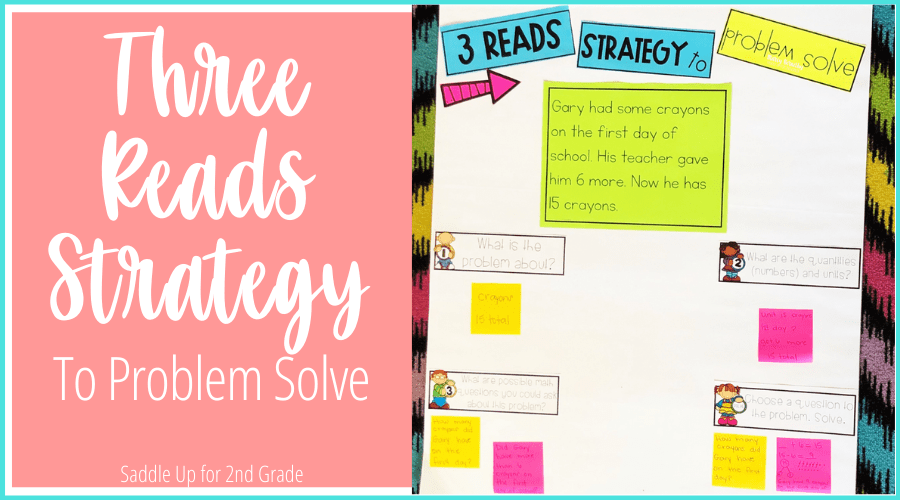
How to Implement the 3 Reads Strategy
In order for the 3 reads strategy to be successful, it’s important that you introduce it to your students by explaining the various steps and the goal of each step. Just like the strategy says, let your students know that you will be reading the math problem 3 times. Each time you read the word problem, you will be looking for different pieces of information each time. This is a much different approach than other problem solving strategies in math, but it is highly effective.
You can watch a break down of the 3 reads strategy in my YouTube video below.
First Read: What is the problem about?
Teacher reads the problem stem out loud only.
The most important concept for your students to understand is that with the first read, they will NOT be able to see the math problem. The teacher will read the question orally while your students listen carefully. They will begin to think about what the problem is about.
I always provide an opportunity after the first read for my students to turn and talk with their shoulder partner about what they just heard.
Overall, the main objective of this step is for students to get a general, brief overview of the word problem. Do not worry if your students don’t pick up on the small details yet. We will work on that in the next step.
3 Reads Strategy Anchor Chart
During the first read, I like to guide students with this 3 reads strategy anchor chart. This will help you visually represent the various pieces of information you’re looking for during the reads and help guide your students’ thinking.


Second Read: What are the quantities (numbers) & units?
Teacher displays the math problem and tells students to focus on the numbers within the problem..
Throughout the second read of the 3 reads strategy, students will now be given the first opportunity to see what the math problem looks like. You can share it on your whiteboard or under your document camera. Sometimes I would print the problem on a piece of paper and have it face down on my students’ desks. During this step they would be allowed to flip the paper over and look at the problem.
In the course of the second read, I also like to have the whole class participate in a choral read of the math problem. Since this is the first time they are actually seeing the problem, it can be helpful to read it aloud together. One of the key factors for this step is to inform students that there are always quantities or numbers that need to be counted within mathematical problems.
3 Reads Strategy Interactive Notebook Activity
Students can use this interactive notebook activity to break down the 3 reads problem solving strategy in math. You can have students cover the word problem during the first read or have them glue it to the top of their page during the 2nd read.
They can lift the flap and record their thoughts about what the problem is about. They will use this activity to guide their thinking through all of the reads. This goes along perfectly with the whole class 3 reads strategy anchor chart.

Third Read: What are the possible math questions you could ask about this problem?
Teacher chooses one student to read the question one last time..
As this student is reading the question for the final time, it’s crucial for your class to think about any math questions they can come up with about the problem. I always like to use this step to ask my students, “Can we come up with multiple questions that we can ask about this problem?”
You will notice that you may have to do a little extra digging to really get students thinking during this step. Sometimes probing a few extra questions is necessary so that your class can think more critically and still stay on track. List all the possible questions that your students come up with and decide which one you want to tackle together.

How To Teach Word Problems
You can have this FREE 3 Reads Strategy problem solving template sent straight to your inbox to use with your own students. All you need to do is fill out the form below. I recommend using your home email address because school spam filters like to block these emails sometimes.
After you’ve done the 3 reads strategy for problem solving a few times as a whole group, give students the opportunity to try it on their own with a partner. Working on problem solving strategies in math is one of the best ways to set students up for success!
If you’re looking for resources where you can incorporate this strategy, be sure to check out my problem solving units ! You can find examples of word problems comparing part-part whole-whole unknown as well as comparing difference unknowns !
You can also check out my problem solving strategies in math posters to help your students break down what to look for when solving word problems.
Shop This Post
Check out these problem solving resources.
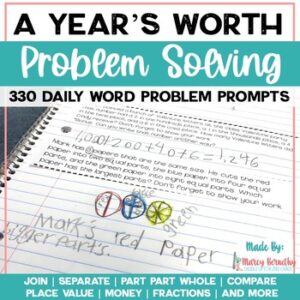
A Year’s Worth of Problem Solving Journal Prompts Bundle
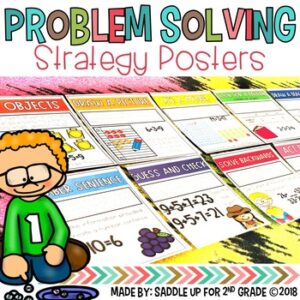
Problem Solving Strategy Posters
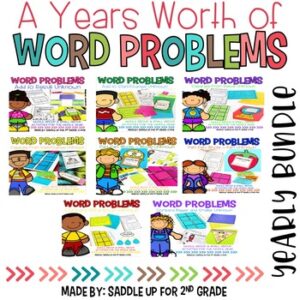
2nd Grade Word Problems for the Year – Comparing Numbers, Part Part Whole, etc.
Looking for more tips for teaching problem solving strategies in math?
Check out these blog posts:
- The Power of Numberless Word Problems
- Why I Stopped Teaching Keywords in Word Problems
Feel free to pin the image below to save this post for later!

You might also like...
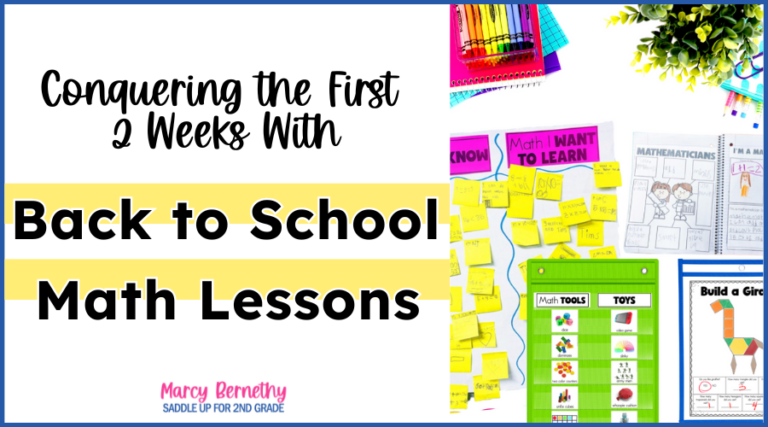
Conquering The First Two Weeks of Math | Fun Back to School Math Lesson Plans for 1st-3rd Grade
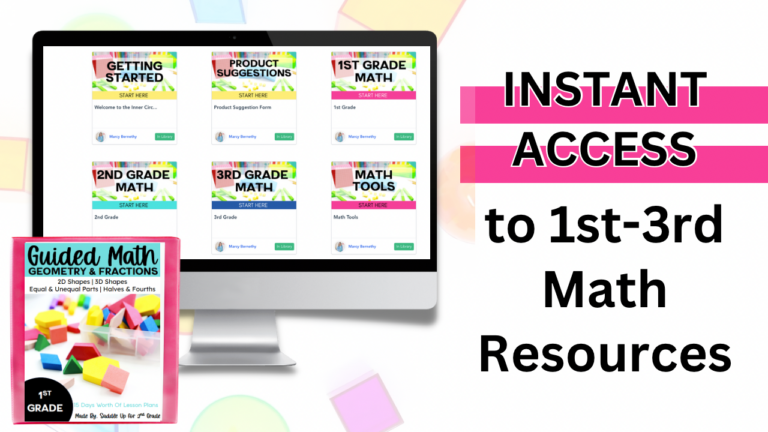
The Ultimate Teacher Membership for Stress-Free Elementary Math Lesson Planning
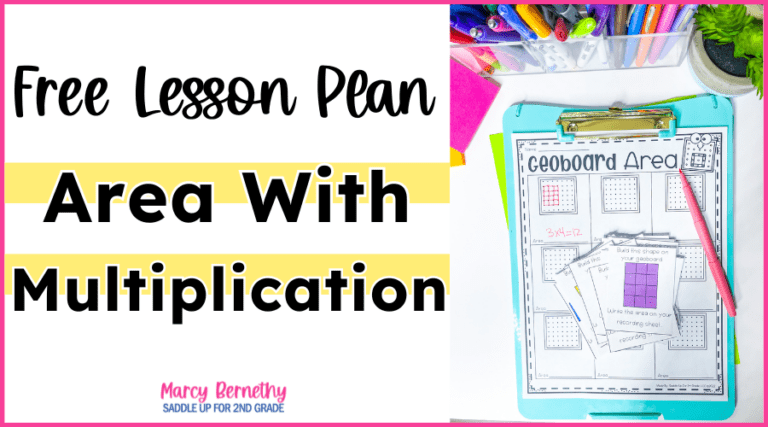
Teaching Area With Multiplication | Free Measurement Lesson Plan for 3rd Grade
Say Goodbye to Timed Tests
Math should be fun, not stressful. Ditch the timed math fact tests and replace them with math games that will help your students learn and retain information more effectively.
© Saddle Up for 2nd Grade • Website by KristenDoyle.co
Site search
Three-read protocol.
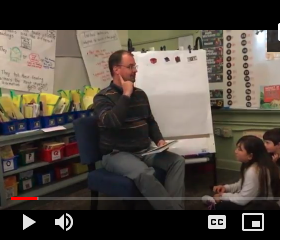
Watch a video of a Three-Read Protocol
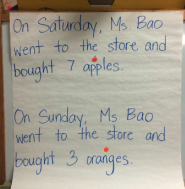
Pre-K and K
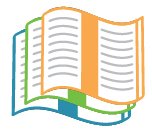
The Three-Read Protocol is one way to do a close read of a complex math word problem or task. This strategy includes reading a math scenario three times with a different goal each time. The first read is to understand the context. The second read is to understand the mathematics. The third read is to elicit inquiry questions based on the scenario. Why would I use this strategy? The Three-Read Protocol is designed to engage students in sense-making of language-rich math problems or tasks. It deepens student understanding by surfacing linguistic as well as mathematical clues. It focuses attention on the importance of understanding problems rather than rapidly trying to solve them. It allows for the use of authentic, instead of overly simplified, text. This strategy also allows for natural differentiation within a class of diverse learners. When do I use this strategy? This strategy can be used for math tasks that include complex language structures or language that lends itself to a variety of interpretations. While this is a particularly useful strategy for English Language Learners, all students can benefit from the deeper understanding of word problem structures and open-ended questioning. How do I use this strategy? The Three-Read Protocol uses the “problem stem” of a word problem. This is essentially the word problem without the question at the end. The purpose of presenting the problem stem alone is to have students focus on the contextual and mathematical information before dealing with any question that is involved. This gives students the freedom to create their own questions for a given scenario, which is an excellent skill to develop both in math and in reading in general. It is important that the teacher choose the problem carefully and anticipate potential linguistic and mathematical roadblocks the students may encounter. 1. First Read: Teacher reads the problem stem orally. The teacher may have visuals to accompany the oral read of the problem stem. Students listen to the story with the goal of turning to a partner and sharing what they remember of it. Memorizing it is not necessary. Students may act out the problem if that helps them grasp the context. Key Question: What is this situation about? After the Turn-and-Talk, the teacher asks students to volunteer information they remember from the story. Teachers and students ask clarifying questions about the vocabulary as needed.
Read more about the Three-Read Protocol. 2. Second Read: Class does choral read or partner read of the problem stem. The teacher projects the problem stem so the whole class can see it. The teacher leads the class either in a choral read of the problem or has partners read the problem orally to each other. Choral read is preferable because it allows all students to participate without excessive pressure, but a partner read can work fine if that is a better fit to the classroom culture or age of students. The teacher explains that math stories usually have information about quantities (numbers) and the units that are being counted. Key Question: What are the quantities in the situation? An example is 25 cats, where “25” is the quantity and “cat” is the unit. Sometimes the quantities are implied. For example, “some cats” implies a quantity but we do not know what it is. There can also be implied units. An example is “I have one at home.” The implied unit in this case depends on the context of the story. Bottom line: The discussion of quantities and units can be important for focusing student attention, but how deeply the teacher delves into the explicit and implicit information depends on the math and language objectives. 3. Third Read: Partner or choral read the problem stem orally one more time. The teacher asks students to do one more read of the “story” and asks them to think, “What is missing to make this a good math problem?” Students volunteer their answers to that question. Responses will likely vary because many students assume there is a question without actually reading one. Without correcting student responses, the teacher probes until the class decides that a question is missing. The teacher asks, “Is there only one question that we can ask of this story?” Students responses may vary, but there are usually many different questions that can be asked of almost any scenario. Key Question: What mathematical questions can we ask about the situation? The teacher asks partners to determine at least two questions that can be asked using the problem stem. Students share their questions. The teacher writes a couple of the questions and clarifies language as appropriate. After each question, the teacher asks the class, “Can this question be answered with the information from this story?” and the class discusses why or why not. 4. Students work in collaborative groups on the problem. Students work in groups to solve a question based on the problem stem. The teacher may assign a specific question for all groups to answer, or groups may choose a question from the list asked by the class. If groups are asked to choose their own questions, it is important that the teacher circulate and clarify expectations for the work. This can be an opportunity to differentiate the math work because the range of possible questions to a problem stem is broad.
Read more about the Three-Read Protocol in the Math Teaching Toolkit .
The original source materials for the Three Read Protocol is the Routine for Reasoning Fostering Mathematical Practices in All Students , where you will find additional resources.
This page was last updated on February 29, 2024
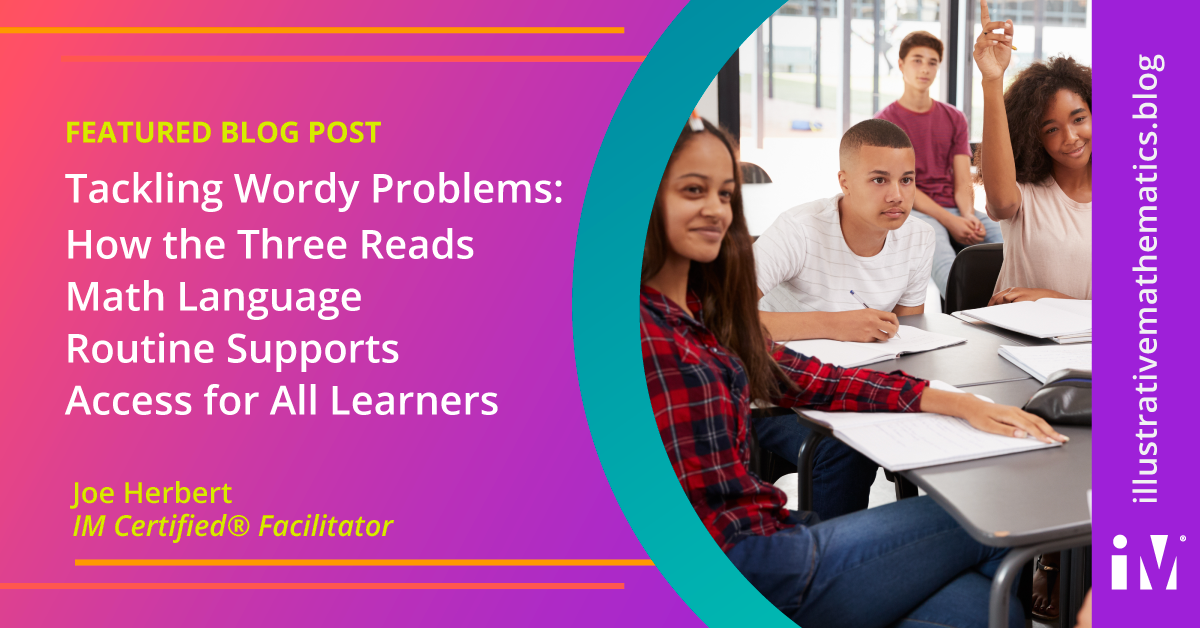
Tackling Wordy Problems: How the Three Reads Math Language Routine Supports Access for All Learners
by Joe Herbert
“These problems are great, but they’re just so wordy. My students can’t handle all that reading!”
Does this feel familiar? If so, you’re not alone! Many students and teachers struggle with the language demands of IM 6–12 Math when they first start their implementation journey.
Students may not be used to the level of reading and writing in math that this curriculum requires, and teachers may be unsure of how to support students with these literacy demands, particularly if their students are more comfortable in a language other than English.
Luckily, the curriculum authors have integrated eight Mathematical Language Routines (MLRs)* into the curriculum to support teachers in amplifying, assessing, and developing students’ language.
While these routines are specifically tagged as supporting Access for English Learners, they are actually beneficial to all learners.
One of the core tenets of language support in this curriculum is that we amplify rather than simplify language. I’m going to be honest: when I first heard the phrase “ amplify rather than simplify ,” I was confused by what it meant. But by digging into one of the Mathematical Language Routines— MLR6: Three Reads**—I finally understood the philosophy, and why it is so powerful in making sure that all students have access to mathematics, while keeping the focus on authentic sense-making.
In this blog post, I’m going to walk through the mechanics of implementing MLR6: Three Reads using an example from the curriculum. I’ll also share some anecdotes and tips from my experience facilitating this routine—both in a GenEd classroom, and in a sheltered class dedicated to newcomers who are just beginning to learn and use English.
While I’m going to illustrate this routine using a high school example, this same routine structure can be applied to middle school and even elementary school contexts.
The example we’ll look at in this post comes from Geometry Unit 5 Lesson 17 . I think it’s always helpful to know where students are in their learning trajectory, especially when looking at an example that comes so late in a unit. Before this lesson, students have thought deeply about volume, and know how to find the volume of many solids. Early in this lesson, they’re introduced to the concept of density as an application of volume.
With that in mind, here is the activity:
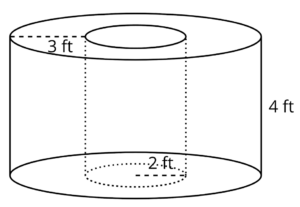
The best average density for the species of fish that will go in the tank is 16 fish per 100 gallons of water. This provides enough room for the fish to swim while making sure that there are plenty of fish for people to see.
The aquarium has 275 fish available to put in the tank. Is this the right number of fish for the tank? If not, how many fish should be added or removed? Explain your reasoning.
If your head is spinning from all of the information you’re trying to keep track of in this problem, you’re not alone! Every teacher can probably think of at least one student (and maybe a whole class of students!) who would get intimidated by this problem and not know where to start.
That’s where MLR6: Three Reads comes into play. Rather than simplifying the problem and removing some of the academic rigor, Three Reads provides a structured format for teachers and students to partner in amplifying the language in the problem, so that students are able to understand it and engage in authentic sense-making.
Let’s dig into how the routine does this. As the name suggests, in the Three Reads routine, we engage in three structured readings of the same problem context, with a slightly different and more focused lens each time.
Read 1: Understand the Story Context
In the first read, the goal is just to understand the context of the problem.
To help students focus solely on the story context, we remove the question. Thus, in our example, we would just share the following with students:
The aquarium has 275 fish available to put in the tank.
When doing this first read, I often read out loud to the class. Alternatively, you can have a student read out loud. If you teach English Learners, this is the time to bring in visual aids, such as pictures from your local aquarium.
The discussion that follows Read 1 has a very clear goal: make sure students understand the story context of the problem, and address any non-mathematical vocabulary words that might get in students’ way.
After the shared reading, we ask students “What is this situation about?” or “What is the story of this problem?”
Then, scribe their ideas on the whiteboard or some other shared space.
Students sometimes start jumping to talking about the numbers that are in the problem, but I specifically ask them to tell me what the story of the problem is without referencing any numbers at all. By the end of this discussion, I want to make sure students know what a fish tank is, and that they recognize the unique shape of the particular fish tank in this problem. I might even draw a little stick figure in the inner cylinder to really drive the point home.
Read 2: Identify Quantities
The second time we read the problem together, we again omit the question so that students can focus exclusively on making sense of the context. The mechanics for how I implement Read 2 sometimes differ depending on the audience.
With newcomers who are just learning how to read (and speak!) in English, I like to do a choral read aloud. This gives students a low-stakes opportunity to practice reading in English, because everyone is reading at the same time so no one individual voice can be easily heard.
In my experience, in a GenEd classroom, high schoolers prefer to read the problem together in small groups, rather than choral reading.
Now for the important part: the questions we ask and discussion we have after Read 2.
Here is where we ask students, “What can be counted or measured?”, without focusing on any specific numbers. In our Geometry example, this might include the volume of the tank, the density of fish, the dimensions of the tank, and the number of fish available.
When working with newcomer English learners, I have had some trouble explaining what I mean by the question “What can be counted or measured?”. In that case, I modify the routine slightly to ask students what quantities they see in the problem, and I specify that a quantity is a number and its unit***. Thus, rather than just identifying the number 3, for example, students will identify that the distance between the inner and outer cylinders is 3 feet.
Regardless of the specific prompt you give students, the main goal for Read 2 is for students to begin to think more deeply about the various quantities in the problem, how they’re related to each other, and how they relate to the overall story context. As in Read 1, we scribe students’ ideas on the whiteboard to help make our collective thinking visible.
Read 3: Reveal the Questions and Plan Solution Strategies
Read 3 is where we read the context one last time, and then reveal the actual questions students will investigate.
The mechanics for Read 3 can be whatever works best for your students: choral reading, reading in small groups, or one volunteer reading out loud.
After the shared reading, the discussion prompt for Read 3 is, “What are some ways we might solve this?” The goal is for students to do some high-level planning and strategizing before they jump into the nitty gritty of computation.
In our example, we might have students who talk about finding the total volume of the big cylinder, and then subtracting the volume of the smaller cylinder. Alternatively, they might discuss finding the area of the base of the fish tank and multiplying it by the height to find the volume.
By discussing these ideas and strategies in partner pairs or as a whole class, we set kids up for success when we release them to independent or group work.
Amplify, Don’t Simplify
I hope this breakdown of MLR6: Three Reads makes clear how we can use Mathematical Language Routines to amplify rather than simplify language. By engaging in this routine, we’re not changing the wording of the problem to make it simpler. Rather, we’re using the three structured reads and discussion prompts to amplify the language in the problem and help students make sense of the problem for themselves.
The first time I tried Three Reads in the classroom, I had several students who had arrived in the US earlier that week. They were just starting to learn English, and did not feel very comfortable with it yet. However, after engaging in the routine, they made sense of the problems authentically, and offered meaningful contributions to their groups. (I of course encouraged students to discuss the problems with peers in whatever language they felt most comfortable with.)
This was when I truly understood the incredible power of this routine to help create a world where all learners know, use, and enjoy mathematics.
I hope that this leaves you eager to try MLR6: Three Reads in your classroom, regardless of the student population you teach.
If you’re feeling excited but still a little intimidated, I’d like to draw your attention to the Illustrative Mathematics teacher notes. I think it’s helpful to see how much support the curriculum authors have given teachers in making IM 6–12 Math accessible to all.
This is the suggestion to support Access for English Learners for the fish tank activity:
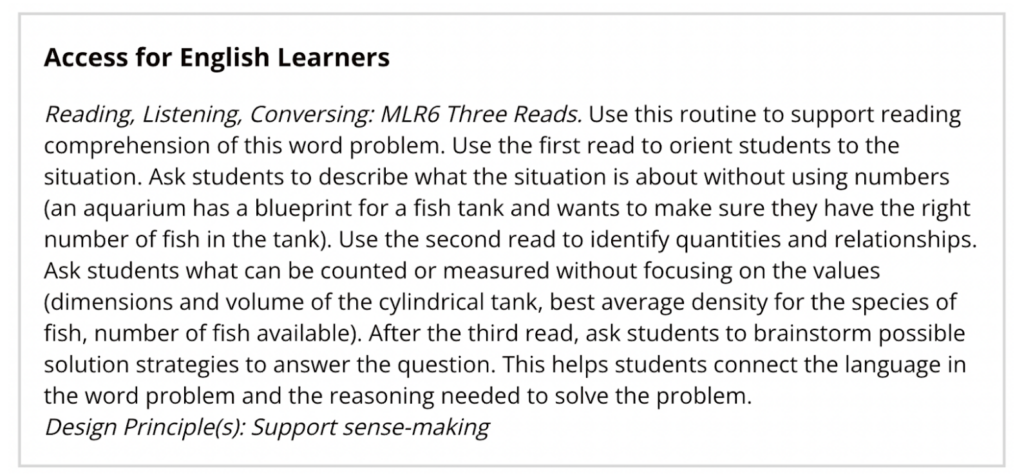
Notice how this suggestion goes beyond just saying, “do Three Reads,” and instead highlights the important ideas that you want to draw out of the conversation after each of the three reads.
Does MLR6: Three Reads take some extra instructional time? Yes, of course. However, if your students are able to dive straightaway into authentic sense-making after engaging in the routine, then it is time well spent.
So the next time you get overwhelmed thinking about how your students are going to struggle with a wordy problem, take a look at the suggestions for access that are built into the curriculum. Whether or not you teach English learners, you might find a suggestion for a Mathematical Language Routine that provides the perfect support to help you amplify rather than simplify language for your students!
*Zwiers, J., Dieckmann, J., Rutherford-Quach, S., Daro, V., Skarin, R., Weiss, S., & Malamut, J. (2017). Principles for the Design of Mathematics Curricula: Promoting Language and Content Development
**Kelemanik, G, Lucenta, A & Creighton, S.J. (2016). Routines for reasoning: Fostering the mathematical practices in all students. Portsmouth, NH: Heinemann.
*** This modification for Read 2 comes from the Three Reads protocol distributed by San Francisco Unified School District
to the IM Blog and Newsletter
RECENT POSTS
- Reintroducing the IMplementation Reflection Tool August 29, 2024
- Preparation Matters: Using Strategic Planning to Maintain the Magic in Math Communities All Year Long August 22, 2024
- Annotate and Acknowledge August 9, 2024
- Getting Ready for 2024–2025 Back to School with Illustrative Mathematics August 1, 2024
- Getting Started with Illustrative Mathematics July 11, 2024
- Back to School (5)
- Coaches Corner (1)
- Grades 3–5 (111)
- Grades 6–8 (121)
- Grades 9–12 (97)
- Grades K–2 (92)
- Grades K–5 (57)
- Partners (4)
- Professional Learning (78)
- Recent Blog Posts (8)
- Uncategorized (3)
Popular Tags
- Our Mission
- Big Ideas of Early Math
- Precursor Concepts
- Racial Justice
- Learning Labs
- Instructional Coaching
- Leadership Academies
- Online Learning
- Professional Learning Modules
- Teacher Change
- Publications
- Presentations
- Measuring Math
- Summer Institutes
- Promising Math
- Projects and Partnerships
- Contributors
- Español de México
- MyDashboard
- Login or Join Today
Series: Ideas at Work
Exploring the three-reads math protocol for word problems.
January 29, 2018 This is an Article - for grade levels Pre-K , Kindergarten , 1st Grade , 2nd Grade , 3rd Grade
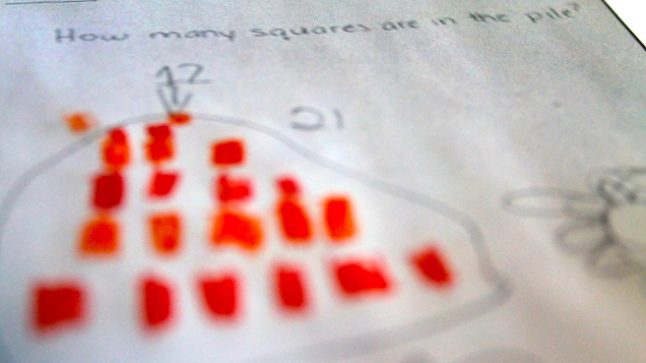
Teachers in four schools recently experimented with a “problem stem” protocol for helping their children understand the math going on in the word problems they face in class. This was part of our Big Shoulders project, which has been working with Chicago-area schools for the last five years.
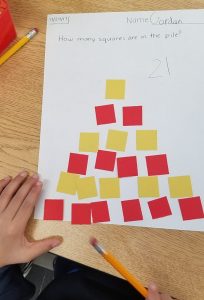
- The first time, the goal is to comprehend the text (context). So it does not involve numbers or the question itself. The teacher may ask how they would describe the situation in their own words? What do they think is the context of the story?
- The second time, the goal is to comprehend the mathematical structure of the problem. This introduces the numbers but does not pose any questions. At this point children may make a class list of possible questions, or perhaps make observations about the quantities.
- The third time, the goal is to list all the possible mathematical questions. At this point the questions are laid out and students can discuss different ways of thinking as well as perhaps create diagrams to analyze the questions that are posed.
Many of the teachers read Beyond Answers by Mike Flynn as well as used the 3-act lesson resources posted by Graham Fletcher on his website gfletchy.com .

Another teacher that is part of the project at St. Terese used the 3-Act problem Counting Squares to explore pattern and numbers. After being shown a picture of the pile, the kindergarten class discussed the situation and what questions may be posed about it. Students then used different approaches to solving the problem: How many tiles are in the pile. After working on solutions, the class came back together to discuss how making a pattern helped them answer the question to how many tiles were in the pile. An extension to the problem was if there was one more row added to the bottom, how many tiles would be in that row and what color would they be.
More Resources on the Three-Reads Protocol:
- The 3-Read Protocol – SFUSD Mathematics Department
- Strategy Showcase: 3 Reads – Mister, Is This Right? Blog

Launch Problem Solving with Understanding Using Three Reads
In this lesson launch, we see a third-grade teacher using reading comprehension strategies to help children understand a math story problem using Three Reads.
Why is this important?
Later issues with word problems can often stem from the inability to fully understand the context of the problem and the question being asked. Protocols such as problem stems and Three Reads can be useful tools so children can be primed for understanding word problems in mathematics.
Do the math.
Free videos., free newsletter packed with ideas., free professional learning modules., join the collaborative.
- Comments This field is for validation purposes and should be left unchanged.

Just one more step to access this resource!
Get your free sample task today.
Ready to explore Exemplars rich performance tasks? Sign up for your free sample now.
The Three Reads Protocol: Understanding vs. Solving
Written By: Nakoa Wiley, Professional Learning Specialist and Curriculum Designer, GA
With a rapid transition into virtual teaching and learning, teachers are facing challenges with finding instructional resources that employ the same rigor and critical thinking received from students in the traditional classroom setting. Since it seems that virtual teaching is the “new norm,” many believe it is in best practice that teachers focus on the mastery of previously taught standards vs. introducing new standards. With that being said, implementing performance tasks into virtual teaching and learning will continue to: (1) elicit critical thinking and authentic learning from students, (2) allow for more personalized teaching for each student (responsive teaching), and (3) allow for learning activities or assessments to be scaffolded for mastery. Performance tasks can be used as a part of daily instruction or for assessing skills taught.
The Three Reads Protocol is a stand-alone strategy that deepens a student’s understanding of the structure of rich tasks. It encompasses open-ended questioning which embodies the framework for all performance tasks. Unlike commonplace procedures such as CUBES or SOLVE, this instructional routine is evidence-based and sets the precedence for our students to “think like mathematicians”.
The Three Reads Protocol
The Three Reads Protocol is one way to do a close read of a complex math task. This strategy includes reading a math scenario three times with a different goal each time. The first read is to understand the context. The second read is to understand the mathematics. The third read is to elicit inquiry questions based on the scenario. The Three Read Protocol is designed to engage students in sense-making of language-rich math problems or tasks. It deepens student understanding by surfacing linguistic as well as mathematical clues. It focuses attention on the importance of understanding problems rather than rapidly trying to solve them. It allows for the use of authentic, instead of overly simplified, text. This strategy also allows for natural differentiation within a class of diverse learners. (SFUSD Mathematics Department, June 2015, sfusdmath.org)
What it Looks Like in the Virtual Learning Platform
| Teacher Behaviors | Key Question | Student Behaviors | |
|---|---|---|---|
| Preparation |
| ||
| 1st Read | |||
| 2nd Read | |||
| 3rd Read |
| ||
| Collaborative Groups |
Student behaviors can be modified for primary grade levels and based on student need. The Three Reads Protocol supports standards-based instruction and helps scaffold teaching and learning in any educational platform. This strategy will also help students develop constructive academic conversations around mathematical content.
Note 1: * Denotes changes to protocol to align to virtual teaching and learning.
Note 2: Google offers a variety of collaboration tools that may be used by students such as the chat and comment feature in Docs, Gmail, and Hangouts. Platforms such as Zoom, Skype, and FaceTime may also be used to promote communication as well as the chat feature in a school's LMS.

COMMENTS
The 3 Reads Protocol is a powerful tool for improving comprehension of word problems. Check out an example and see how easy it is to use!
The 3 Reads Strategy helps students make sense of complex word problems. Read through the steps to start implementation in your classroom.
Although there are multiple problem solving strategies in math, one of my favorite ways to break down these steps is to use the 3 reads strategy for problem solving. Read on to learn how it works! How to Implement the 3 Reads Strategy
Three Reads math routine is a powerful tool to set your students up for mathematical success by equipping them with strategic problem-solving. Apply impactful mathematical routines in your classroom now by using free resources from our Ask Emily video series: “Which One Doesn’t Belong?”.
The Three-Read Protocol is one way to do a close read of a complex math word problem or task. This strategy includes reading a math scenario three times with a different goal each time. The first read is to understand the context. The second read is to understand the mathematics.
Read 3: Reveal the Questions and Plan Solution Strategies. Read 3 is where we read the context one last time, and then reveal the actual questions students will investigate. The mechanics for Read 3 can be whatever works best for your students: choral reading, reading in small groups, or one volunteer reading out loud.
Launch Problem Solving with Understanding Using Three Reads. In this lesson launch, we see a third-grade teacher using reading comprehension strategies to help children understand a math story problem using Three Reads. View. Why is this important?
The Three Read Protocol is designed to engage students in sense-making of language-rich math problems or tasks. It deepens student understanding by surfacing linguistic as well as mathematical clues. It focuses attention on the importance of understanding problems rather than rapidly trying to solve them.
Three Reads: Making Sense of the Problem In Just 3 Simple Steps! 1. Problem Stem: The problem without a question which offers students a brief description of some quantitative information. Focus on the context of the problem (comprehension) 2. Students Pose Questions They Want to Answer: Students brainstorm questions that they want to answer about
3 Reads Strategy for Problem Solving. Problem solving is not always what it seems. Many times, solving a mathematical problem requires several steps to get the final answer. ...more....